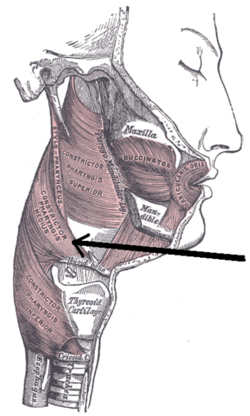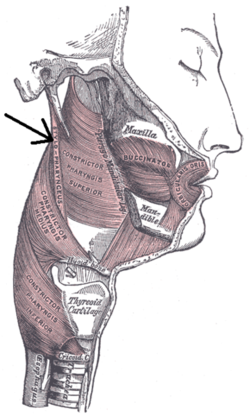The pharynx (plural: pharynges) is an organ found in vertebrates and invertebrates, though the structure is not universally the same across the species. In humans the pharynx is part of the digestive system and also of the conducting zone of the respiratory system. The conducting zone also includes the nose, larynx, trachea, bronchi, and bronchioles, and their function is to filter, warm, and moisten air and conduct it into the lungs. It makes up the part of the throat situated immediately posterior to the nasal cavity, posterior to the mouth and superior to the esophagus and larynx. The human pharynx is conventionally divided into three sections: the nasopharynx, the oropharynx and the laryngopharynx. It is also important in vocalization.
Structure

Nasopharynx
The upper portion of the pharynx, the nasopharynx, extends from the base of the skull to the upper surface of the soft palate. It includes the space between the internal nares and the soft palate and lies above the oral cavity. The adenoids, also known as the pharyngeal tonsils, are lymphoid tissue structures located in the posterior wall of the nasopharynx. Waldeyer's tonsillar ring is an annular arrangement of lymphoid tissue in both the nasopharynx and oropharynx.
Polyps or mucus can obstruct the nasopharynx, as can congestion due to an upper respiratory infection. The eustachian tubes, which connect the middle ear to the pharynx, open into the nasopharynx. The opening and closing of the eustachian tubes serves to equalize the barometric pressure in the middle ear with that of the ambient atmosphere.
The anterior aspect of the nasopharynx communicates through the choanae with the nasal cavities. On its lateral walls are the pharyngeal ostia of the auditory tube, somewhat triangular in shape, and bounded behind by a firm prominence, the torus tubarius or cushion, caused by the medial end of the cartilage of the tube that elevates the mucous membrane. Two folds arise from the cartilaginous opening:
- the salpingopharyngeal fold, a vertical fold of mucous membrane extending from the inferior part of the torus and containing the salpingopharyngeus muscle
- the salpingopalatine fold, a smaller fold extending from the superior part of the torus to the palate and containing the levator veli palatini muscle. The tensor veli palatini is lateral to the levator and does not contribute the fold, since the origin is deep to the cartilaginous opening.
Behind the opening of the auditory tube is a deep recess, the pharyngeal recess (also referred to as the fossa of Rosenmüller). On the posterior wall is a prominence, best marked in childhood, produced by a mass of lymphoid tissue, which is known as the pharyngeal tonsil. Superior to the pharyngeal tonsil, in the midline, an irregular flask-shaped depression of the mucous membrane sometimes extends up as far as the basilar process of the occipital bone, this is known as the pharyngeal bursa.
Oropharynx
The oropharynx lies behind the oral cavity, extending from the uvula to the level of the hyoid bone. It opens anteriorly, through the isthmus faucium, into the mouth, while in its lateral wall, between the palatoglossal arch and the palatopharyngeal arch, is the palatine tonsil. The anterior wall consists of the base of the tongue and the epiglottic vallecula; the lateral wall is made up of the tonsil, tonsillar fossa, and tonsillar (faucial) pillars; the superior wall consists of the inferior surface of the soft palate and the uvula. Because both food and air pass through the pharynx, a flap of connective tissue called the epiglottis closes over the glottis when food is swallowed to prevent aspiration. The oropharynx is lined by non-keratinised squamous stratified epithelium.
The HACEK organisms (Haemophilus, Actinobacillus actinomycetemcomitans, Cardiobacterium hominis, Eikenella corrodens, Kingella) are part of the normal oropharyngeal flora, which grow slowly, prefer a carbon dioxide-enriched atmosphere, and share an enhanced capacity to produce endocardial infections, especially in young children. Fusobacterium is a pathogen.
Laryngopharynx
The laryngopharynx, (Latin: pars laryngea pharyngis), is the caudal part of the pharynx; it is the part of the throat that connects to the esophagus. It lies inferior to the epiglottis and extends to the location where this common pathway diverges into the respiratory (larynx) and digestive (esophagus) pathways. At that point, the laryngopharynx is continuous with the esophagus posteriorly. The esophagus conducts food and fluids to the stomach; air enters the larynx anteriorly. During swallowing, food has the "right of way", and air passage temporarily stops. Corresponding roughly to the area located between the 4th and 6th cervical vertebrae, the superior boundary of the laryngopharynx is at the level of the hyoid bone. The laryngopharynx includes three major sites: the pyriform sinus, postcricoid area, and the posterior pharyngeal wall. Like the oropharynx above it, the laryngopharynx serves as a passageway for food and air and is lined with a stratified squamous epithelium. It is innervated by the pharyngeal plexus.
The vascular supply to the hypopharynx includes the superior thyroid artery, the lingual artery and the ascending pharyngeal artery. The primary neural supply is from both the vagus and glossopharyngeal nerves. The vagus nerve provides a branch termed "Arnolds Nerve" which also supplies the external auditory canal, thus hypopharyngeal cancer can result in referred otalgia. This nerve is also responsible for the ear-cough reflex in which stimulation of the ear canal results in a person coughing.
Clinical significance

Inflammation
Pharyngeal cancer
History
Etymology
The word pharynx (pronounced /ˈfærɪŋks/) is derived from the Greek φάÏυγξ phárynx, meaning "throat". Its plural form is pharynges /fəˈrɪndÊ'iËz/ or pharynxes /ˈfærɪŋksÉ™z/, and its adjective form is pharyngeal (/ËŒfærɪnˈdÊ'iËÉ™l/ or /fəˈrɪndÊ'iÉ™l/).
Other animals

Vertebrates
All vertebrates have a pharynx, used in both feeding and respiration. The pharynx arises during development in all vertebrates through a series of six or more outpocketings on the lateral sides of the head. These outpocketings are pharyngeal arches, and they give rise to a number of different structures in the skeletal, muscular and circulatory systems. The structure of the pharynx varies across the vertebrates. It differs in dogs, horses and ruminants. In dogs a single duct connects the nasopharynx to the nasal cavity. The tonsils are a compact mass which point away from the lumen of the pharynx. In the horse the auditory tube opens into the guttural pouch and the tonsils are diffuse and raised slightly. Horses are unable to breathe through the mouth as the free apex of the rostral epiglottis lies dorsal to the soft palate in a normal horse. In ruminants the tonsils are a compact mass which point towards the lumen of the pharynx.
Pharyngeal arches are characteristic features of vertebrates whose origin can be traced back through chordates to basal deuterostomes who also share endodermal outpocketings of the pharyngeal apparatus. Similar patterns of gene expression can be detected in the developing pharynx of amphioxus and hemichordates. However, the vertebrate pharynx is unique in that it gives rise to endoskeletal support through the contribution of neural crest cells.
Pharyngeal jaws are a "second set" of jaws contained within the pharynx of many species of fish, distinct from the primary (oral) jaws. Pharyngeal jaws have been studied in moray eels where their specific action is noted. When the moray bites prey, it first bites normally with its oral jaws, capturing the prey. Immediately thereafter, the pharyngeal jaws are brought forward and bite down on the prey to grip it; they then retract, pulling the prey down the eel's esophagus, allowing it to be swallowed.
Invertebrates
Invertebrates also have a pharynx. Invertebrates with a pharynx include the tardigrades,annelids and arthropods, and the priapulids (which have an eversible pharynx).
The term "pharynx" is used loosely across the animal kingdom for the portion of the digestive tract loosely analogous to the vertebrate pharynx, but this need not imply deep structural or developmental similarities, or that the structures are homologous.
The "pharynx" of the nematode worm is a muscular food pump in the head, triangular in cross-section, that grinds food and transports it directly to the intestines. A one-way valve connects the pharynx to the excretory canal.
Additional images

See also

- This article uses anatomical terminology; for an overview, see anatomical terminology.
- Nasopharyngeal carcinoma
- Pharyngeal consonant
- Pharyngeal (disambiguation)
- Pharyngitis
- Saccopharynx, a genus of deep sea eel-like fishes with large mouths, distensible stomachs and long scaleless bodies
- Tonsil
- Uvula
References

This article incorporates text in the public domain from the 20th edition of Gray's Anatomy (1918)
General
- Pharynx, Stedman's Online Medical Dictionary at Lippincott Williams and Wilkins
- Human Anatomy and Physiology Elaine N. Marieb and Katja Hoehn, Seventh Edition.
- TNM Classification of Malignant Tumours Sobin LH & Wittekind Ch (eds)Sixth edition UICC 2002 ISBN 0-471-22288-7
External links
- Anatomy photo:31:st-1401 at the SUNY Downstate Medical Center
- Anatomy photo:31:st-1403 at the SUNY Downstate Medical Center
- Anatomy photo:31:st-1406 at the SUNY Downstate Medical Center

